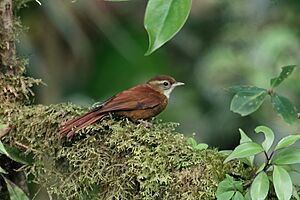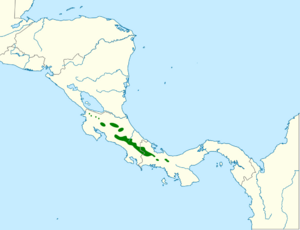Ruddy treerunner facts for kids
Quick facts for kids Ruddy treerunner |
|
|---|---|
 |
|
| Conservation status | |
| Scientific classification | |
| Genus: |
Margarornis
|
| Species: |
rubiginosus
|
 |
|
The ruddy treerunner (Margarornis rubiginosus) is a small bird. It belongs to the ovenbird family. You can find this bird in the mountains of Costa Rica and Panama.
Contents
What is a Subspecies?
The ruddy treerunner has two types, called subspecies. They are a bit different from each other. One is named M. r. rubiginosus. It was first described by George Newbold Lawrence in 1865. The other is M. r. boultoni. Ludlow Griscom described it in 1924.
What Does the Ruddy Treerunner Look Like?
The ruddy treerunner is about 15 to 16 centimeters (6 inches) long. It weighs between 17 and 24 grams (about 0.6 to 0.8 ounces). Both male and female birds look the same.
Colors and Markings
This bird has a light, yellowish-white stripe above its eye. It also has a light ring around its eye. Its face is a dull reddish-brown color. The top of its head is dull reddish-brown. It has a thin, lighter reddish collar around its neck. Its back and the top parts of its wings are a reddish-chestnut color. The main flight feathers are dark brown with reddish edges. Its tail is a slightly lighter reddish-chestnut. The ends of its tail feathers look spiky.
Belly and Legs
The throat of the bird is whitish. Its chest is a dull reddish-brown. It has pale "V" shapes on its upper chest. Darker spots are on its lower chest. Its belly is mostly dull reddish-brown. Its sides and the feathers under its tail are a darker chestnut brown. The bird's eyes are dark brown. Its beak is brown to black on top and pinkish-white underneath. Its legs and feet can be grayish-green or dull pinkish-brown.
Young Birds and Subspecies Differences
Young ruddy treerunners have less clear markings on their chest. The M. r. boultoni subspecies has a deeper yellowish-white stripe above its eye. Its upper parts are a bit darker. Its underparts are a richer, deeper cinnamon color. It has fewer and smaller markings on its chest.
Where Does the Ruddy Treerunner Live?
The ruddy treerunner lives in high mountain areas. It is found in different, separate places. The M. r. rubiginosus subspecies lives from northern Costa Rica down into Panama. This includes the Chiriquí Province in Panama. The M. r. boultoni subspecies lives in eastern Chiriquí and Veraguas Provinces in Panama. These birds live inside and at the edges of mountain evergreen forests. They are found at heights between 1,200 and 3,000 meters (about 3,900 to 9,800 feet) above sea level.
How Does the Ruddy Treerunner Behave?
Movement
The ruddy treerunner stays in the same area all year long. It does not migrate.
What Does the Ruddy Treerunner Eat?
This bird eats many different kinds of insects and other small creatures. It usually looks for food alone or in pairs. Often, it joins groups of different bird species that are feeding together. It can be found looking for food at any height in the forest. The ruddy treerunner is very agile. It climbs up tree trunks and along branches. It picks prey from branches and plants growing on trees. Sometimes, it even hangs upside down to find food!
Reproduction and Life Cycle
The breeding season for the ruddy treerunner is not fully known. It seems to be from March to May. The bird builds an oval-shaped nest. It uses moss, pieces of plants, and ferns. The nest is attached to a tree trunk. Inside, the nest is lined with plant fibers and fern scales. The entrance to the nest is a tube at the bottom. We don't know how many eggs they lay. We also don't know how long the eggs take to hatch. And we don't know how long it takes for the young birds to leave the nest. It looks like both parent birds help to hatch the eggs. Both parents also care for the baby birds in the nest.
What Sounds Does It Make?
The ruddy treerunner's call is a thin, whistling "tsit." It usually makes these sounds in a fast, uneven series. It also makes "metallic chirping notes" and a trilling sound that goes down in pitch.
Is the Ruddy Treerunner in Danger?
The IUCN (International Union for Conservation of Nature) says the ruddy treerunner is of "Least Concern." This means it is not currently in danger of disappearing. Even though it lives in a small area, there are many of them. Scientists think there are between 20,000 and 50,000 adult birds. This number seems to be stable. No immediate threats to the bird have been found. People think it is fairly common or common. It lives in some protected areas. However, rules about protecting these areas are not always strictly followed.


